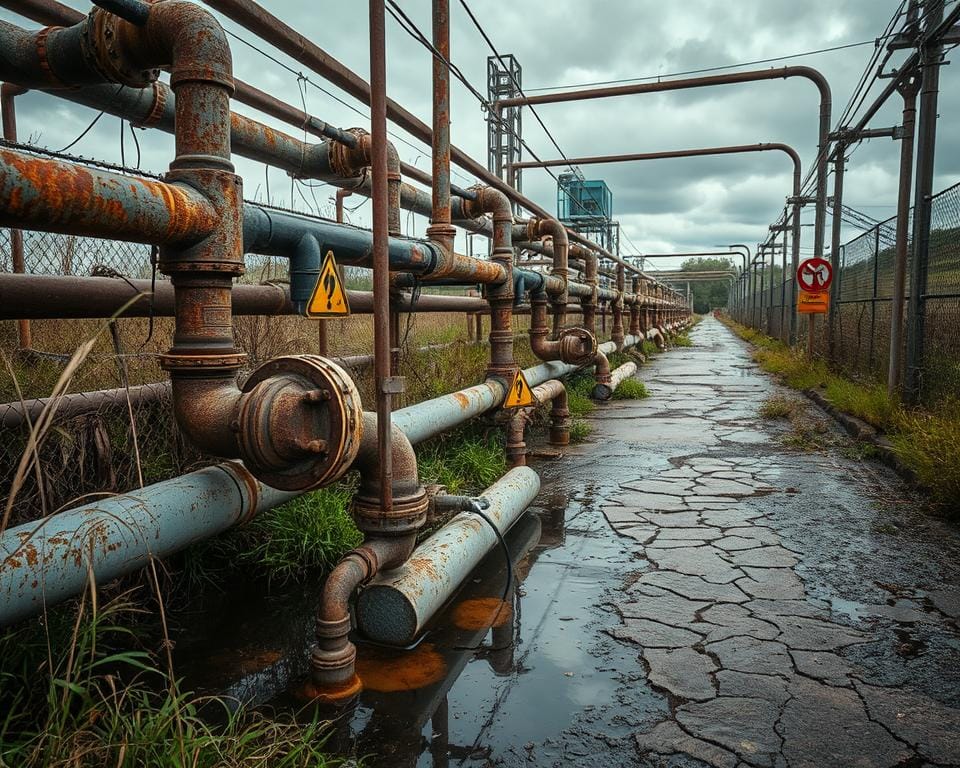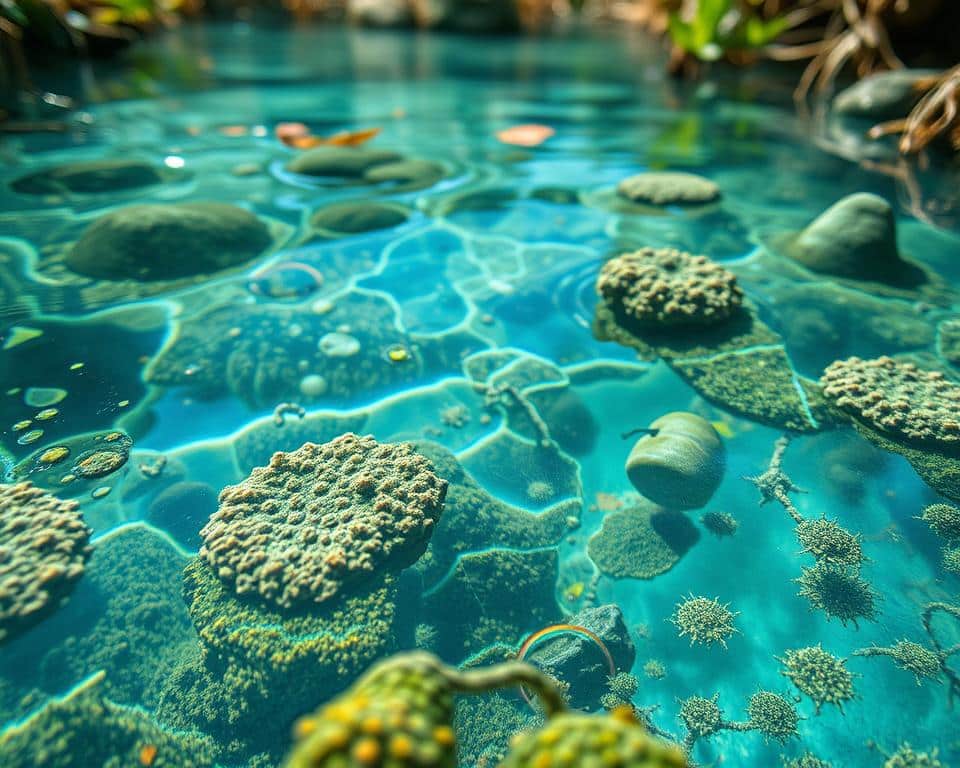Being aware of water contamination risks is key for our health. We use various water sources every day. Spotting contamination signs in tap, bottled, and well water is crucial to prevent health problems. For instance, a fishy taste or a rotten egg smell suggests pollution.
Seeing cloudy, discolored, or bad-smelling water means bacteria and chemicals might be present. Also, low water pressure can point to bigger issues in the water system. If you have stomach or neurological problems, or long-term exposure to water toxins, get the water tested right away.
Certain groups like kids, pregnant women, the elderly, and those with weak immune systems face more risk. Devices like the Adya Clarity purifier or gravity water filters can make water safer. Knowing the dangers of public or private well water is essential for taking action.
For more in-depth information on identifying water contamination, you can check out this detailed article.
Common Sources of Water Contamination
Knowing the common sources of water contamination is vital for safe drinking water. Various sources can affect water quality and pose health risks. We will look at three main areas: municipal water systems, private wells, and bottled water.
Municipal Water Systems
Municipal water systems supply treated water to our homes and businesses. These systems follow the Safe Drinking Water Act but can still face issues. Problems in the treatment process or old pipes can allow dangerous chemicals like lead and harmful pathogens such as Cryptosporidium, E. coli O157, and Legionella. It’s important to know the risks that come with municipal water.
Private Wells
Contaminants in private wells are a big worry since no regulatory bodies monitor them. Bacteria, viruses, pesticides, and heavy metals can get into wells from farms, septic systems, and factories. It’s crucial to test and maintain these wells regularly. For details on well water testing, check out this guide on testing for glyphosate. Keeping your well in good shape means regular checks and fixing any problems quickly.
Bottled Water
Some think bottled water is safer than tap water. Yet, bottled water’s safety can also be at risk from its source or during bottling. Checking the brand and source of your bottled water is key to confirming its safety. Even in bottled water, there might be pathogens and chemicals, posing health risks.
Each water source comes with its own set of issues and ways to lower contamination risks. By keeping informed and checking these sources, we can protect our health and drink safer water.
Key Water Contamination Signs to Watch For
Watching for changes in your water’s taste, odor, and look is vital. These changes can warn us of possible water pollution. Common signs include taste shifts, bad smells, and water that looks cloudy or colored.

Changes in Taste
A change in taste is a major hint that your water might be contaminated. If water tastes bad, like it’s metallic or bitter, that’s a sign. These tastes can mean there are heavy metals like lead in your water. Keep tasting your water to make sure it stays safe.
Unpleasant Odors
Bad smells from your water can also mean contamination. A rotten egg smell suggests sulfur bacteria, while a bleach scent could mean too much chlorine. These smells mean you should check your water.
Cloudy or Discolored Water
Seeing your water turn cloudy or different in color is a warning. This can happen due to iron, manganese, algae, or dirt in the water. If your water isn’t clear, you might need more tests and fixes to keep it safe.
Here’s a quick guide to what these signs mean:
| Sign | Possible Cause | Health Risk |
|---|---|---|
| Metallic or Bitter Taste | Heavy Metals (Lead) | Neurological Issues, Chronic Health Effects |
| Rotten Egg Odor | Sulfur Bacteria | Gastrointestinal Problems |
| Bleach-like Odor | Excessive Chlorine | Skin Irritations |
| Cloudiness or Discoloration | Iron, Manganese, Sediments | Various Health Risks |
Health Symptoms Caused by Contaminated Water
Drinking contaminated water can lead to health problems. This can include stomach issues, nerve damage, or skin problems because of harmful substances in the water.
Gastrointestinal Issues
Contaminated water often causes stomach problems. Pathogens like E. coli and Giardia can cause serious symptoms. These include bad stomach pain, diarrhea, and throwing up. They can lead to diseases like typhoid and cholera. For example, E. coli from a bad well can make you very sick with cramps and vomiting.
Testing your water at home can help prevent these illnesses.
Neurological Symptoms
Drinking bad water can also affect your nervous system. Being exposed to a lot of heavy metals, like lead and arsenic, can harm your brain. You might feel dizzy, get headaches, or have worse long-term problems. Kids exposed to these metals can have development issues and adults might face higher cancer risks.
Skin Irritations
Skin problems from bad water can also hint at bigger health issues. Rashes and itching from chlorine, pesticides, or metals in water are common. These skin signs are crucial to watch. They may point to more dangerous health problems.
Understanding these health effects and acting quickly, like testing water and asking doctors for advice, can cut down risks from waterborne diseases and other issues. Know the dangers various water contaminants bring, and stay informed about their effects.
Testing Your Water Quality
It’s crucial to make sure your water is pure and safe. Water quality tests can show what harmful things might be in it. This helps you know how to clean it up.
Home Water Test Kits
are handy. They can find bad stuff like germs, nitrates, and heavy metals. But, they don’t catch everything that professional tests can.
People who have wells should test for certain things regularly. These include germs, pH levels, how much stuff is dissolved in the water, and nitrates. This keeps the water safe.
Professional Water Testing Services
Getting your water tested by experts is a good move for more detail. Special labs know how to look for dangerous chemicals, lead, arsenic, and more. The EPA says to use approved labs, especially well owners. They need to check for harmful bacteria like E. coli often.
These labs also check how acidic your water is. This helps stop harmful metals from getting into the water from your pipes. Keeping your water safe is their goal.
Different things stand out when you compare home kits to expert services:
| Features | Home Water Test Kits | Professional Water Testing Services |
|---|---|---|
| Convenience | High | Moderate |
| Cost | Low to Moderate | Moderate to High |
| Accuracy & Detail | Basic | Comprehensive |
| Detection Range | Limited | Extensive |
| Recommendation & Reporting | Minimal | Detailed |
Choosing between DIY kits or expert testing is key. Doing regular checks helps keep your water safe. Knowing how to read the results is also important for your family’s health.
For more details on trusty tests, visit how to turn off water leak.
Water Treatment Options
It’s important to make sure our drinking water is clean and safe. There are many things that can pollute our water. But, there are also many ways we can clean our water, depending on what we need.
Water Filters
Water filters can vary a lot. They range from simple pitchers to complex systems for the whole house. They help get rid of things like dirt, bad tastes, smells, and some chemicals. Filters that you attach right to your sink give you clean water exactly where you need it. These filters can really improve the water you drink and use every day.
Water Purifiers
Water purifiers take cleaning to the next level. They get rid of harmful tiny life forms. These systems use special processes like reverse osmosis or boiling to clean the water well. This is really important in places where dangerous germs are in the water. With these purifiers, you know your water is not just clean, but also safe to drink.
Boiling Water
Boiling water is a simple, old way to kill germs. It’s great for getting rid of bacteria and viruses. But, it doesn’t take out chemicals or heavy metals. Boiling is a good option in emergencies or when you can’t use other methods. It helps make sure your water is safe to drink for a short time.
| Water Treatment Method | Benefits | Drawbacks |
|---|---|---|
| Water Filters | Removes particles, improves taste and odor, easy installation | May not remove all pathogens or heavy metals |
| Water Purifiers | Eliminates bacteria, viruses, and other pathogens | Higher initial cost, maintenance required |
| Boiling Water | Inexpensive, effective against pathogens | Doesn’t remove chemical contaminants or heavy metals |
Water Contamination Signs in Public Systems
Public water systems, despite strict rules, can get contaminated. This affects the safety of the community’s water. Spotting the signs of dangerous public water early is key to avoiding health risks. One early sign of contamination in public water is weird smells. A strong, bad odor may mean the water has harmful things or germs in it.

How water looks is also important in spotting issues. Water that’s cloudy or weirdly colored might be contaminated. Also, seeing trash or dead animals near water places is a big warning. Such signs should make people alert the town quickly. They should stop using the water until it’s fixed.
It helps to know about germs that can be in water. Here are some stats on how they can make people sick:
- Legionella: Causes illnesses such as cough, fever, headaches, muscle aches, and shortness of breath.
- Norovirus: Symptoms include diarrhea, vomiting, nausea, and stomach pain.
- Rotavirus: Leads to severe watery diarrhea, vomiting, fever, and stomach pain.
- Campylobacter, E. coli O157, and Shigella: Can cause bloody diarrhea, fever, stomach cramps, and abdominal pain.
- Hepatitis A: Symptoms such as dark urine, clay-colored stool, fatigue, fever, joint pain, and jaundice.
Boiling water for 1 minute can kill many germs. This includes Crypto, Campylobacter, E. coli O157, and many others. Knowing about these germs and what they do is crucial for keeping water safe in our communities.
Keeping public health safe starts with each person being watchful. Quickly responding to water warnings from the town is vital. By doing this, we can keep our community safe from water contamination.
Conclusion
It’s important to act against water contamination to keep your family safe. Look out for signs like weird tastes, bad smells, and water turning strange colors. These signs mean your water may not be safe. Testing your water often helps find dangers like bacteria, metals, and toxins quickly.
Water filters and purifiers reduce health risks by cleaning your water. Brands like Adya Clarity make products that remove many contaminants. Boiling water is also a simple way to kill germs. This is especially important for kids, pregnant women, older people, and anyone with a weak immune system.
Understand how your public water system works and if it follows the Safe Drinking Water Act. If you know about water problems early, you can act fast to protect your health. But if you find out late, health problems and doctor visits might go up. Keeping an eye on your water quality is key. It helps everyone live healthier.

